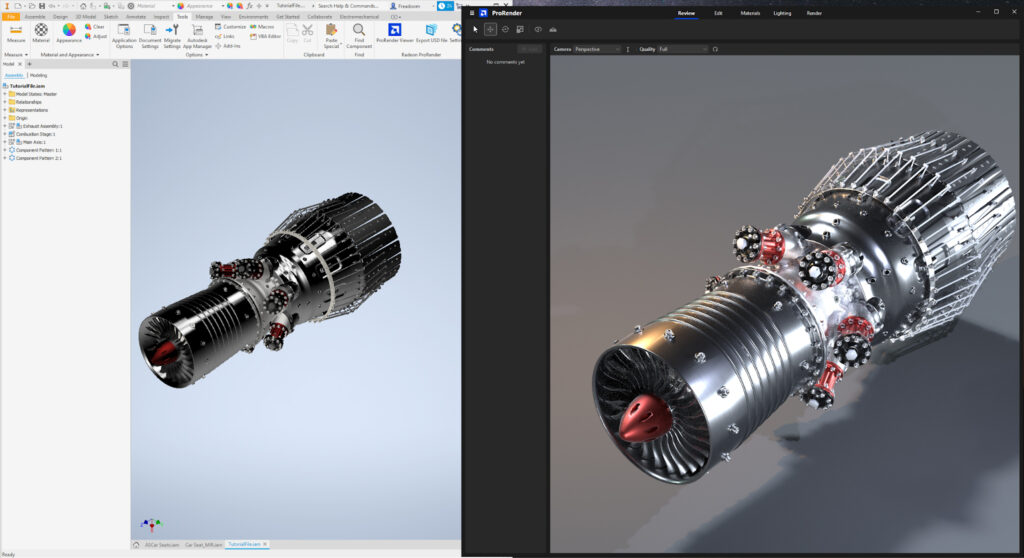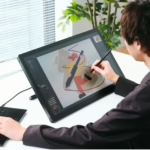
AMD has announced that its physically-based rendering engine, Radeon ProRender, is now available as a free, downloadable plug-in for Autodesk Inventor 2021 and 2022. It will help Inventor users create photorealistic images of their parts and assemblies. Radeon ProRender is built on AMD’s accelerated ray intersection library, Radeon Rays. Radeon ProRender uses open, common rendering standards, Pixar’s Universal Scene Description (USD) and MaterialX, and supports hardware-accelerated raytracing on GPUs. USD is being used for sharing geometry, and the MaterialX standard is being used for authoring and sharing material appearances.

Autodesk Inventor is a professional-grade 3D CAD software with product design and engineering capabilities. The Radeon ProRender plug-in adds a companion Radeon ProRender viewer and rendering app to Inventor, which enables users to easily create photorealistic visualizations of their designs with just a few mouse-clicks, says AMD.
Autodesk says that AMD Radeon ProRender for Inventor supports Inventor 2022. Inventor 2021 users can use it but the live link to get model updates from Inventor will not function. According to the Github page for this plug-in, the plug-in for Inventor broadly includes the following two parts which are being developed to work together but can also function separately:
- A plug-in for Autodesk Inventor, which exports Inventor data into USD and sends this data to a companion viewer application, named RPR Viewer.
- The RPR Viewer application which opens USD data, allows reviewing, editing and saving it, and handles lighting, material editing, and final rendering, also all enabled with USD and MaterialX technologies.
The press release by AMD follows:
AMD Radeon ProRender for Autodesk Inventor Now Available
AMD Radeon ProRender is our fast, easy, and incredible rendering engine built on industry standards that lets you create stunningly photorealistic images on virtually any GPU, any CPU, and any OS. Radeon ProRender is already available in over a dozen leading DCC and CAD applications and our latest release is a plug-in for Autodesk Inventor 2021 and 2022.
Inventor is a professional-grade 3D CAD software for product design and engineering and our free downloadable Radeon ProRender plug-in and viewer application for Inventor adds the ability to easily create photorealistic visualizations of your designs with just a few mouse-clicks.
The plug-in adds a companion Radeon ProRender viewer and rendering app to Inventor that uses the latest rendering standards, USD and MaterialX, and supports hardware-accelerated raytracing on AMD RDNA 2 architecture-based graphic cards, including our latest professional graphics card, the AMD Radeon Pro W6800.
Design Visualization Options for Inventor
Design visualization has become a very important step in today’s product design workflows. Being able to generate photorealistic images of your designs so you can easily show off what the finished product will look like is key to accelerate internal design reviews, successful client presentations, and for creating compelling sales and marketing tools.
While Inventor users already have a selection of visualization tools available to them, they are either be aimed at advanced users and require a significant time investment to use, or don’t support faster GPU-accelerated rendering. Our Radeon ProRender plug-in for Inventor offers instead an easy-to-use yet powerful photorealistic visualization tool that can take full advantage of your graphics cards for rapid results.
Key Features of the Plug-in and Viewer
The Radeon ProRender Inventor plug-in once installed adds a “ProRender Viewer” button to Inventor that when clicked opens the companion ProRender Viewer and imports your assembly to it. The Viewer is designed to be easy to use even for those with little to no experience with rendering. When you import your design into it, the base colors and materials are carried over and for fast results you can simply render out you design “as-is.”
However, to improve the quality of your renders you can also easily apply to your design the life-like realistic materials from the included MaterialX-based Radeon ProRender library of 303 Physically based rendering (PBR) materials. You can view all the materials available here, and the library includes a wide selection of materials from natural materials like stone and wood, all the way to composites and anodized metals.
On top of that, you can add a ground plane and enhance the lighting by adding HDRI background images and adjusting other lighting settings to create an even more realistic representation of your design. The Radeon ProRender viewer also has “live link” capabilities with Inventor 2022 which lets you continue to work on your design in Inventor and see it automatically updated with your changes in the viewer as you work. This feature is not available if using the viewer with Inventor 2021.
Additional Features, Including Hardware Raytracing
The Radeon ProRender Viewer also includes many of the features and benefits found in our other Radeon ProRender plug-ins for other creative applications, including Adaptive Sampling that optimizes render times and AI-Accelerated Denoising for clean noise-free images in less time.
Another key feature introduced when the base Radeon ProRender rendering engine was updated to v2.0 is dedicated hardware-accelerated raytracing on AMD RDNA 2 architecture graphics cards. Although Radeon ProRender is GPU-accelerated on all OpenCL 1.2 and higher compatible graphics cards (including Nvidia GPUs), on supported products, hardware raytracing can optimize your render times even further.
Support for hardware-accelerated rendering is available on AMD Radeon RX 6000 series and AMD Radeon Pro W6000 series graphics cards, and the significantly shorter render times it can provide means you can get back to designing faster than ever.
Looking to the Future with the Latest Rendering Tech
Not only does our Radeon ProRender Plug-in for Inventor include all many of the great features found in our other Radeon ProRender plug-ins, but it is also built upon some of the latest rendering technologies that could become the industry standards of tomorrow.

By using the Pixar USD (Universal Scene Description) framework, a new standard for transporting 3D data between different content creation, design, and rendering applications, your Inventor designs can also easily be exported to the USD format and brought into any application that supports USD without having convert or adjust them for use in these applications. The same goes in reverse if you want to import USD content into the Viewer. Examples of leading application that supports USD are Autodesk Maya 2022 and 3ds Max 2022 (beta support).

Like USD, MaterialX is an open, common standard (created by Lucasfilm) for the transfer of information between applications and renderers, but this time for materials. The Radeon ProRender material library that comes with our Inventor plug-in uses MaterialX, allowing for easy and accurate transfer of the same look for your design when it is imported into applications that also support MaterialX.
Support for both technologies shows that Radeon ProRender is looking to the future of rendering when all 3D data will be based on open and common standards and easily transferrable between any number of applications without any headaches for designers.
Download Info and System Requirements
The AMD Radeon ProRender Plug-in and Viewer for Inventor is available to download from the Autodesk store today. Radeon ProRender is optimized for AMD Radeon Pro and Radeon RX graphics cards (and supports hardware raytracing on Radeon RX 6000 and Radeon Pro W6000 series GPUs) and like many of AMD’s technologies, it is built on open standards and works on any GPU that supports OpenCL 1.2 (including NVIDIA graphics cards) and on any CPU.
To learn more about how to use the plug-in, see our documentation and watch the tutorial videos here.





